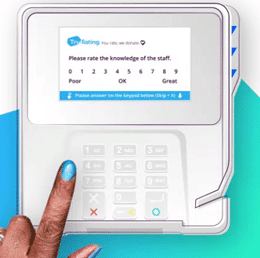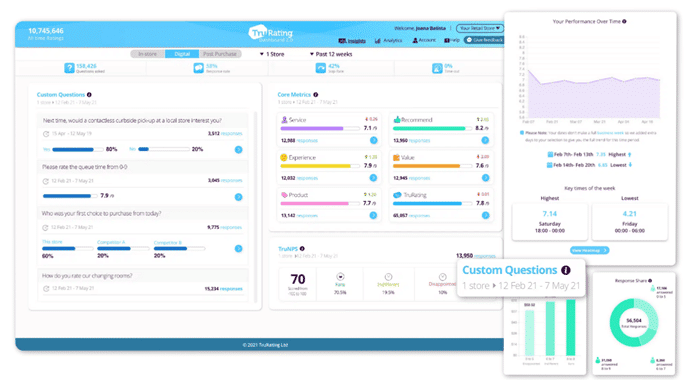With the distance that was created between consumers and brands during the pandemic, companies have sought to have more frequent, bite sized feedback with their customers, and there has been some movement toward technologies that provide quicker, shorter, and more real time feedback. There is a growing number of companies either solely targeting a quicker hit format or those that offer it in addition to a full list of options. However, short formats do not necessarily equate to a sparse dataset.
Dash Research recently had a demo with TruRating, a company that provides an intelligence and analytics platform that is tied to time of payment, bringing together validated feedback and transactional data. This data can be collected at time of purchase in store or online as well as post purchase, and always in a micro-survey, one question format. Additionally, the collected ratings can also be leveraged into a consumer-facing recommendation platform. TruRating customers include Blacks Outdoor, Bealls, New Balance and Longos.
Kelsey Erickson, Head of Global Sales; Amy Daugherty, Global Head of Marketing & Innovation; and Marty Schecter, Global Head of Product Management recently walked me through TruRating’s approach to helping retailers provide great CX, and gave me a view into their dashboards and reporting. TruRating offers their customers micro-surveys that ask one question with a potential “Tell Us More” included. From an end user perspective, its solution is easy and fast to use, and there is the satisfaction of knowing that with each rating TruRating donates to its global charity partners. There is also the satisfaction of knowing that their data is completely anonymized. For the companies deploying the solution, it is a plug and play set up with an average response rate in store of 80%, and 50% online. TruRating has even seen response rates as high as 91% of all in store transactions. With these high response rates, TruRating customers can get a more widespread cross section of people, hearing not just from the promoters and detractors of the world.

Ratings that are given go directly into a Retailer profile page that feeds into an individual page per retail location, allowing for the most reflective consumer experience. The pages appear in Google search. TruRating does filter out suspect ratings. As an example, its algorithms allow the company to discern patterns that suggest an individual employee might potentially be tampering with the ratings themselves, scoring themselves at the top end of the scale.
Something unique to TruRating is that since it is integrated into payment software either online, or in store, it allows anonymized transaction details to be tied to each purchase so that the link between sentiment and spend can be tied together. Any retailer can be using 20-30 questions, but end users only receive one question at any time. Each micro-survey is partnered with more than 50 data points for a deep, detailed view into each transaction. Additionally, a new product, “Intelligent Questions” can be used in TruRating’s online solution, which helps personalize the questions based on customer type, loyalty segment, website behavior, basket data, etc. All of this results in a large dataset that can get quite granular – down to the shift level at a store.
The TruRating team walked me through their dashboard, which was uncluttered and made it easy to discern the most essential information quickly, which I imagine is a plus for busy retail managers. TruRating puts emphasis on leveraging the data for quick action, and retail ops teams are core users. Teams that are on the floor of a retail outlet don’t need to wait for a big corporate read-out but can get data that is updated every four hours. The data is commonly part of daily or weekly huddles. Kelsey Erickson says, “A lot of CX tools were built for practitioners, but they stay in CX. This tool gets used by the people directly responsible.” It is common for TruRating data to become a KPI itself, allowing teams to easily measure increases or decreases allowing for targeted operational actions to take place: Does a team member on a certain shift need more training? Was the store tidy? Are team members greeting every customer?

The customer insights and feedback segment struggles with issues such as lagging data, suspect ratings, too much outreach and inability to fully engage internal stakeholders. Additionally, there is no one size fits all solution, as company need and CX maturity levels vary widely. Short form survey and ratings tools that can still provide the actionable and verified data needed to improve CX should continue to grow in importance as companies seek ways to balance checking in with their customers along a range of journey touchpoints, while not intrusively over-asking for engagement.
Author Information
As a detail-oriented researcher, Sherril is expert at discovering, gathering and compiling industry and market data to create clear, actionable market and competitive intelligence. With deep experience in market analysis and segmentation she is a consummate collaborator with strong communication skills adept at supporting and forming relationships with cross-functional teams in all levels of organizations.
She brings more than 20 years of experience in technology research and marketing; prior to her current role, she was a Research Analyst at Omdia, authoring market and ecosystem reports on Artificial Intelligence, Robotics, and User Interface technologies. Sherril was previously Manager of Market Research at Intrado Life and Safety, providing competitive analysis and intelligence, business development support, and analyst relations.
Sherril holds a Master of Business Administration in Marketing from University of Colorado, Boulder and a Bachelor of Arts in Psychology from Rutgers University.







